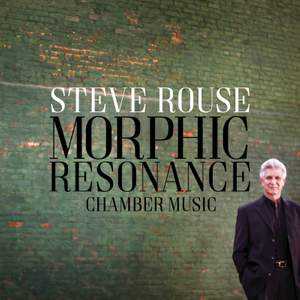Composer Steve Rouse constructs unique and indelible sound worlds on his album MORPHiC RESONANCE, his first release with PARMA Recordings. The album is a revue of Rouse’s chamber music from the last two decades and beyond, and the works featured on MORPHiC RESONANCE demonstrate Rouse’s powerful gifts to create compelling and idiosyncratic musical statements. This quality is most prominent in the work Ten Little Things, a set of short movements for clarinet and percussion. More appropriately, Rouse uses the work to pair solo clarinet with different pitched and unpitched percussion instruments, and he succeeds brilliantly in blending the clarinet’s sound with unlikely partners, such as the tambourine and snare drum, among others. Ten Little Things is endlessly impressive, as each movement sounds like a new world, thanks to Rouse’s willingness to explore the full color palette of the clarinet, namely through microtones, and his disciplined construction of melodic and rhythmic material. Across MORPHiC RESONANCE, Rouse displays the highest level of compositional ability, particularly in the unexpected ways he bases seemingly complex passages on repeated melodic and rhythmic ideas. This technique is critical to the success of Ten Little Things as it further links the clarinet and percussion in the common purpose of the movement, underscoring their total partnership in the music. in Form Fades, for flute, clarinet, cello, violin, piano, and percussion, Rouse demonstrates a winning approach to ensemble writing. Scored for a notably disparate group of instruments, Rouse unites them, at first with a shared melody, throughout with brilliant orchestration. Rouse’s treatment of the ensemble not only connects its components, but also energizes and brings unexpected earthiness to the whole ensemble, which, in the history of twentieth and twenty-first century music, is most commonly associated with intricate, delicate, and erudite compositions. A hidden gem on MORPHiC RESONANCE is Nevolution, Rouse’s duo for corno da caccia – a historical brass instrument dating back to the Baroque period – and piano. Once again, Rouse succeeds in transcending the difficulties of unusual instrumentation and creates an entirely unique, entirely personal, and entirely compelling composition. Most stunning is Nevolution’s middle movement, which is slow and lyrical, showing the tenderness that is also part of Rouse’s musical language. This album is replete with unusual combinations of instruments, particularly in Ten Little Things and Nevolution. Consider how Rouse is able to exploit these pairings and ‘normalize’ them, as it were, into his regular musical language. Although Rouse’s music tends towards intricate and complex ideas, he often employs repetition to make his works more straightforward. Listen for this and consider how this disciplined approach helps to make his music more compelling





